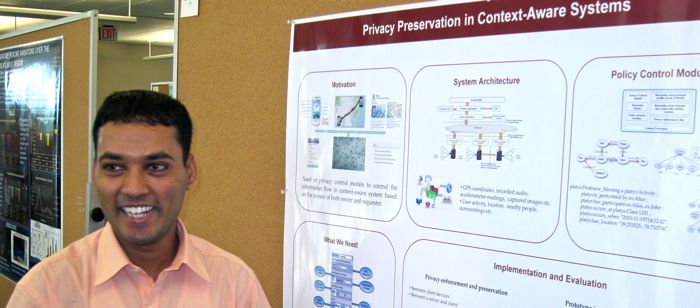CSEE students at the Graduate Research Conference

Twenty CSEE graduate students had oral or poster presentations at the 2011 GRC and CSEE alumnus Dr. Ralph Semmel gave a the keynote address. We have some photographs from the event.
Three of our graduates students were also honored by receiving awards for making outstanding presentations.
- Varish Mulwad received an award for an outstanding oral presentation on his dissertation research on "Generating Knowledge from Tables".
Vast amounts of information are available in structured forms like spreadsheets, database relations, and tables found in documents and on the Web. We describe a framework for automatically understanding and interpreting information encoded in tables and generating knowledge from it. To accurately interpret a table, our framework maps every column header to class (or property wherever appropriate) from appropriate ontologies, link the data values to existing entities from a knowledge base (or map them as values of a property wherever appropriate) and identify and discover relations between various columns. Of the many domains where this work will be useful, we explore the application of this in two important domains — the medical research domain and the open government data. We also present preliminary results evaluating our framework against tables obtained from Google Squared, Wikipedia and a Google dataset.
- Kavita Krishnaswamy received an award for an outstanding oral presentation on her thesis research on "Path planning a roboticarm efficiently".
Individuals with physical disabilities need assistance because of their lack of physical strength. In order to provide a solution, we propose to build an assistive robot to provide physical assistance services for individuals with disabilities in real-time through the Internet. For an assistive robotic arm with a collaborative mode of control, given the initial arm configuration we will attempt to increase the speed of response times for the user requesting physical assistance by calculating the paths of reach to the possible target goals before the time of command. The specific aims of our research project are to a) determine the trajectory path of a human arm to perform tasks; b) identify the paths of frequent use; and c) analyze ways to improve path planning performance. In the first stage, we will investigate the most frequently requested tasks of physical assistance in cases where a robotic arm will be preferred over a personal assistant. For example, if the target task is eating, we may calculate the percentage of volunteering participants picking up a fork, returning the fork, reaching for a cup, and returning the cup. In this study, we utilize the TUM kitchen data set from the Technische Universität München for motion tracking data analysis. With the collected information, we will compute the statistics of the motions to identify paths of frequent use and design the architecture with caching. We anticipate an increase in performance and time will be saved for the computation of path planning. We will begin implementing and testing the new strategies for the proposed architecture.
- Akshya Iyengar received an award for an outstanding poster presentation for her thesis research on "Estimating Temporal Boundaries of Events using Social Media Data".
Social media websites like Twitter, Flickr and YouTube generate a high volume of user generated content as a major event occurs. Our goal is to automatically determine as accurately as possible when the event starts and when it ends by analyzing the volume and content of social media data. We describe a technique that estimates the temporal boundaries of anticipated events like wildfires and hurricanes and helps to monitor changes as events unfold. Estimating these temporal boundaries segments the event"related data into three major phases: the buildup to the event, the event itself, and the post"event effects and repercussions. The technique can also detect the presence and scope of significant sub"events occurring during the course of an event. For events that transpire over time and space, such as the dispersal of an oil spill, a hurricane or a spreading wildfire, we can analyze how event progressed, traveled geographically and major sub"events that occurred within the event. When applied to natural disasters and man-made disturbances, the derived data can help organizations involved in mediation efforts to track and analyze evolving events.
Posted: April 30, 2011, 1:02 PM